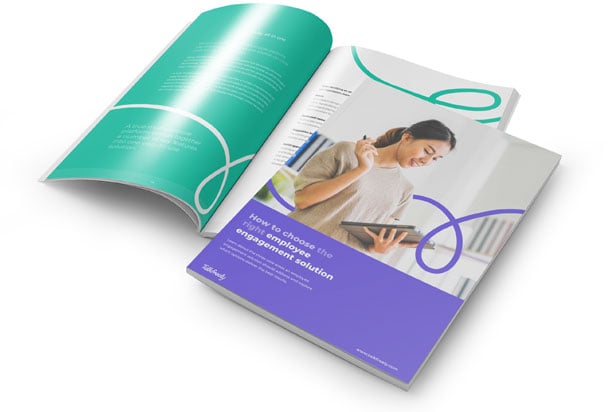What’s the best way to make sure your employees feel valued at work? The answer is surprisingly simple. You just need to listen to them. Everyone wants to feel heard. This is true for all kinds of relationships, whether personal or professional. When a person feels their voice has been heard and their views have been taken into account, they feel satisfied and connected.
This is why the employee voice is so important. The employee voice exists where everyone in the organisation feels they have a say in the decision-making process, where they feel heard and listened to, and their views are taken into account and acted upon. Ensuring your employees feel that they have a voice within your company and that voice is listened to is key to your employee engagement efforts. Without a robust employee voice strategy, you risk increasing the disconnect between employer and employee.
Over the last few years of disruption and upheaval, the voice of the employee has often been lost and ignored. With teams scattered over physical distances, the lack of daily connection and the reliance on video calls rather than actual meetings, many workers began to feel as though they were no longer heard. Now, as offices become populated again, a new divide has opened between those who are office-based and those who still work remotely. Although it is unquestionably easier to listen to those who are immediately present, a good employee engagement model will encompass both parties to ensure an equal platform is provided.
Addressing issues surrounding employee voice will enable you to better engage with your team and encourage innovation in the workplace. The link between employee voice and organisation performance is indisputable. In short, it creates a culture that will underpin your company's success.
What is employee voice?
Before tackling the problem, we first need to die down the employee voice definition. Essentially, employee voice is how individuals communicate their opinions and ideas to their employer and how these views are utilised to influence the company moving forward.
This means that employee voice is much more than simply providing your employees with a way to communicate. It provides your team with a range of platforms and opportunities to connect and actively engage with what your team has to say by utilising their views to guide strategic plans and company direction.
With the new hybrid working methods, we now have a mix of office-based workers and remote staff. These platforms and opportunities must be tailored to fit the circumstances of both sets of employees. It could be that the employee engagement theory that once worked so smoothly is no longer as successful at reaching remote workers. This is when you need to explore new channels of communication. It’s worth exploring the many benefits of employee engagement software, which will help you reach out to every staff member, even those hard-to-reach workers.
The benefits of employee voice
When an employee feels able to share their views and concerns with an employer, the benefits can be far-reaching. By encouraging your team to share their opinions and ideas, you create the potential for your employee voice mechanisms to have a real impact. A strong employee voice and engagement programme can have the following benefits:
- It will drive innovation
- It will provide an early warning for emerging issues
- It will identify training needs
- It will increase work engagement
- It will increase organisational engagement
Employee voice and organisation performance
According to research by Forbes, employees who feel their voices are heard are 4.6 times more likely to produce their best work. The link between employee voice and organisational performance is well-documented. This direct correlation between employee voice and productivity clearly shows the impact an employee voice strategy can have on your business and why it is one of the essential drivers of employee engagement.
As the Gallup research demonstrates, a highly engaged workforce will not only be more productive, but they will also be less likely to take time off. High attendance levels are always at the top of the priority list in every employee engagement strategy. This is especially relevant for your remote workers, who are under greater strain and more likely to experience burnout.
Employee voice mechanisms: Six approaches
Implementing employee voice mechanisms into your company culture is essential to improving employee engagement. However, identifying the best ways to promote employee voice within your organisation may be challenging. The employee engagement ideas outlined below will ensure that your employee’s voices are heard, loud and clear, whether they’re office-based or working from home.
#1 Surveys & polls
Why? Checking in regularly with your team will ensure they feel heard
Utilising surveys to check on specific company areas is a simple and effective way to encourage your employees to have a voice within your company. Scheduling surveys that use a mix of multiple-choice and written responses will enable your team to fully express their views and ideas and provide you with a clear understanding of any issues and insights into how to move forward. This form of listening is ideal for remote workers, who can no longer raise issues with their manager over the water cooler.
Implementing an employee engagement app is an effective way to circulate and manage an employee engagement survey. A robust system will provide detailed tracking and analytics on your surveys, giving you the insights you need to drive change within your organisation. Using an app, you’ll find that it’s easy to reach every single employee, wherever they are based.
#2 Innovation opportunities
Why? Asking for solutions demonstrates to employees that their ideas are valued
Introduce platforms that are purely designed to encourage innovation. One of the key employee engagement best practices is encouraging employees to come up with their own ideas and solutions to problems. These opportunities are often best promoted in a meeting led by an employee not part of the leadership team and can be done on a rota basis. Getting the right management choice and employee voice is a crucial element.
This is a great way to improve employee engagement amongst remote workers and help them connect with the office-based team. Set up an online forum and ask your team to come armed with an idea, no matter how big or small. For this employee voice mechanism to work, you must be inclusive of the entire team, both remote and office-based. Otherwise, your team may feel that only certain voices matter, negatively impacting employee voice and employee engagement and motivation.
#3 Feedback platforms
Why? Employee communication works best when it’s a two-way street
Inviting your team to give regular feedback is a tried and tested way to encourage employee voice and keep your finger on the pulse of your company. This information can then be used to guide company policies and direction. Consider using a designated platform such as an employee app to reach out to employees and gather your answers.
Remember that some employees may find it challenging to use their voice and share opinions if their name is linked to their views. It may be worth considering giving your employees the ability to share feedback anonymously to get an accurate picture of your organisation. Of all the employee engagement activities, inviting feedback is crucial if you’re serious about listening to the voice of the employee.
#4 Regular one-to-ones
Why? Nothing beats the personal touch of face-to-face, individual meeting
Regular one-to-ones are essential to increase employee engagement levels and promote employee voice. Providing your employees with the opportunity to guide their own development and share any challenges or ideas with you in a confidential setting will ensure that they feel listened to and valued.
Even if some of your team are working from home, it doesn’t mean that these essential catch-ups should be cancelled. Schedule your online meetings as usual, and you’ll find out any issues before they become significant problems. According to Forbes, 20% of remote employees say they lack a sense of belonging since the pandemic. It’s important to keep listening.
Allow your one-to-ones to be guided by your employees so they can realise their full potential. Giving your team the autonomy to identify training needs and career progression paths will show them how much you value their opinion, one of the critical dimensions of employee engagement. The strong link between employee voice and engagement can’t be ignored.
#5 Social spaces
Why? It’s a natural way to unite the company and cultivate common goals.
With the introduction of hybrid working, it’s become more important than ever to bring the company together as a whole. And the creation of social spaces is one of the employee voice examples that has come to the fore in the last few years. The simple truth is that people love to connect online. So, allow them to do just that.
An employee engagement app offers a quick and easy way to launch your social spaces to the company. Look for apps that provide conversation modules. This will help you create a social space where employees can meet, chat and share ideas – whether in the office or at the kitchen table. As an employee engagement tool, it’s a powerful way to harness the benefits of the employee voice.
Naturally, there are advantages and disadvantages of employee voice facilitation. Some employers may be concerned that the conversation on a social platform will stray from the approved policy. However, on an employee app, it is simple to lock down dedicated group conversations, enable private discussions and monitor the general activity. When considering how to engage employees, a social platform will deliver every time.
#6 Company-wide discussions
Why? Large-scale meetings help to bring the company together as one
Scheduling organisation-wide meetings to encourage innovation and idea-sharing is key to increasing employee voice and engagement. Use these meetings to ask your team what they think the company’s direction should be and what steps are needed to be taken to get there.
Finally, after so long apart, we can reintroduce the traditional conference setting. However, you may still find that not everyone is able to attend in person. This is where large-scale online discussions that include every employee have proved enormously successful. In fact, the virtual company-wide meeting is one of the key employee engagement best practices. Now is the time to bring everyone together as a whole company, ensuring everyone feels included and listened to.
The importance of employee voice
Too often, companies fall into the habit of making plans and creating strategies without the input of the people who will be working to achieve these objectives. But the link between employee voice and organisation performance is absolute. Encouraging your team to have a voice and guide high-level strategies will show your employees just how much you value their opinions and help you identify new and innovative ways to progress your company. It’s time to start listening.










